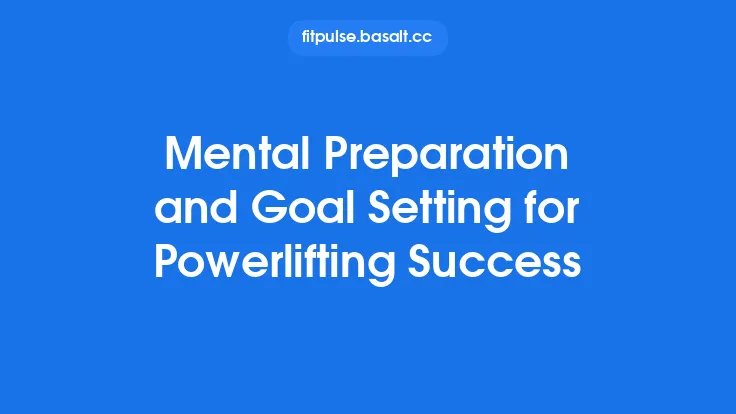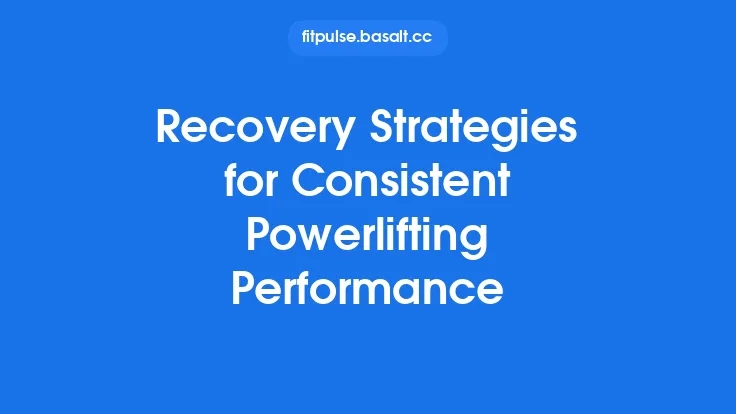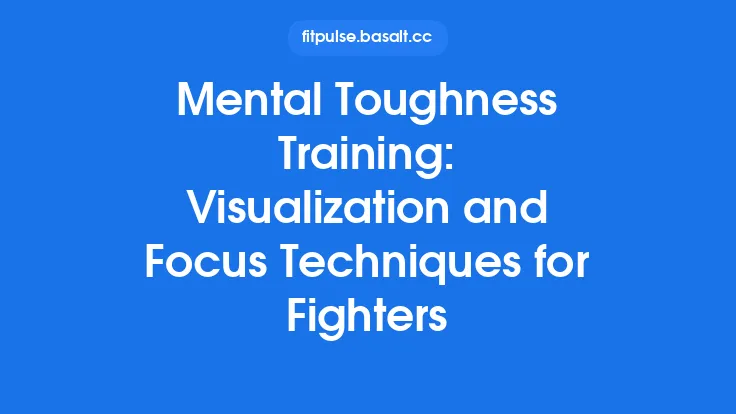Performance anxiety is a common, often misunderstood, barrier that can derail even the most disciplined training plans. While occasional nerves are a natural part of pushing physical limits, chronic or poorly managed anxiety can lead to skipped sessions, inconsistent effort, and a heightened risk of injury. This article delves into the mechanisms behind performance anxiety and presents a toolbox of evidence‑based strategies that athletes, coaches, and fitness professionals can integrate into daily routines to maintain steady progress and protect long‑term health.
Understanding Performance Anxiety in the Athletic Context
Performance anxiety, sometimes labeled “choking” or “stage fright,” is a heightened emotional response triggered by the perceived pressure to meet or exceed a specific standard—whether that standard is a personal PR, a competition result, or a coach’s expectation. Unlike general stress, which can be diffuse, performance anxiety is situational and often spikes in moments that demand immediate execution (e.g., a heavy lift, a sprint start, or a complex skill attempt).
Key characteristics include:
- Cognitive intrusions – racing thoughts about failure, judgment, or past mistakes.
- Somatic arousal – increased heart rate, muscle tension, and adrenaline surges.
- Behavioral avoidance – postponing or skipping training sessions that feel “high‑stakes.”
Understanding that anxiety is a signal rather than a flaw reframes it as a manageable variable within the training equation.
Physiological Triggers and Their Impact on Training Consistency
When anxiety spikes, the autonomic nervous system shifts toward sympathetic dominance. This cascade releases catecholamines (epinephrine, norepinephrine) that:
- Elevate heart rate and blood pressure, potentially compromising fine motor control during technical lifts.
- Increase muscle tone, which can reduce range of motion and alter biomechanics, raising injury risk.
- Accelerate glycogen depletion, leading to premature fatigue during high‑intensity intervals.
Repeated exposure to these physiological states without proper regulation can condition the body to associate training with a stress response, making it harder to achieve a relaxed, optimal performance state over time. Recognizing these triggers is the first step toward interrupting the feedback loop.
Building a Structured Pre‑Training Routine
A predictable pre‑training routine serves as a “psychological anchor,” signaling to the brain that the upcoming session is safe and controllable. Effective routines share three components:
- Environmental Consistency – Arriving at the same location, using the same equipment layout, and setting lighting/temperature to familiar levels.
- Temporal Predictability – Starting at a consistent time of day, allowing the circadian rhythm to align with performance demands.
- Sensory Cues – Incorporating specific sounds (e.g., a short playlist), tactile actions (e.g., tightening shoelaces in a particular pattern), or visual markers (e.g., a training log on the wall).
By rehearsing this sequence before each session, athletes create a conditioned cue that dampens the novelty factor that often fuels anxiety.
Progressive Muscle Relaxation and Autogenic Training
While mindful breathing is a well‑trodden path, other somatic techniques can directly counteract the muscle tension that anxiety provokes.
Progressive Muscle Relaxation (PMR) involves systematically tensing and then releasing major muscle groups, fostering proprioceptive awareness of relaxation. A typical 10‑minute PMR session before a heavy lifting block might follow this order:
- Feet and calves
- Thighs
- Glutes
- Abdominals
- Chest
- Upper back
- Shoulders
- Arms
- Hands
- **Neck and face
Each group is contracted for 4–6 seconds, then released for 10–12 seconds, focusing on the contrast between tension and ease.
Autogenic Training uses self‑suggested statements to induce a sense of warmth and heaviness in the body (“My arms are heavy and relaxed”). Repeating these phrases while seated or lying down can lower sympathetic output without the need for breath‑focused meditation.
Both methods are portable, require no equipment, and can be practiced in locker rooms, on the sidelines, or even during short breaks between sets.
Cognitive‑Behavioral Strategies for Reframing Anxiety
Cognitive‑behavioral techniques (CBT) target the mental scripts that amplify anxiety. The core process involves:
- Identifying Distortions – Spotting “catastrophizing” (“If I miss this rep, I’ll never improve”) or “all‑or‑nothing” thinking (“I must lift my max every session”).
- Challenging Evidence – Asking, “What data do I have that supports or refutes this belief?” Reviewing training logs can provide objective counter‑evidence.
- Constructing Balanced Thoughts – Replacing distorted statements with realistic appraisals (“Missing a rep is a data point, not a verdict”).
A practical worksheet can be kept on a phone app, prompting athletes to log the trigger, the automatic thought, the evidence, and the revised statement. Over time, this habit reduces the automaticity of anxiety‑fueling cognitions.
Exposure and Simulation Training to Desensitize Stressors
Just as exposure therapy helps individuals overcome phobias, athletes can gradually habituate to performance‑related stressors by simulating them in a controlled environment.
- Low‑stakes Repetitions – Performing a target lift at 60 % of one‑rep max while wearing competition attire or in front of a small audience of teammates.
- Incremental Load Increases – Adding 2–5 % of load each session while maintaining the same environmental cues, allowing the nervous system to adapt without overwhelming arousal.
- Timed Challenges – Setting a countdown for a circuit to mimic competition pacing, then debriefing the emotional response afterward.
The key is to keep the exposure intensity just below the anxiety threshold, then slowly raise it as confidence builds. This systematic desensitization reduces the novelty factor that often triggers performance anxiety.
Leveraging Biofeedback and Wearable Technology
Modern wearables can translate internal physiological states into visual data, giving athletes a concrete metric to monitor and regulate anxiety.
- Heart Rate Variability (HRV) – A higher HRV indicates greater parasympathetic (rest‑and‑digest) activity. Apps that provide real‑time HRV scores can cue athletes to engage relaxation techniques when variability drops.
- Galvanic Skin Response (GSR) – Measures sweat gland activity, a direct marker of sympathetic arousal. Sudden spikes can alert the athlete to an impending anxiety surge.
- Respiratory Rate Sensors – While not a breathing technique per se, tracking breathing patterns can help identify hyperventilation episodes that often accompany anxiety.
By reviewing these metrics post‑session, athletes can correlate specific training moments with physiological spikes, refining their mental toolbox accordingly.
Nutrition and Hydration Strategies to Stabilize Arousal
The brain’s neurochemical environment is highly sensitive to macronutrient balance and fluid status. Certain nutritional practices can blunt the physiological edge of anxiety:
- Complex Carbohydrates – Consuming low‑glycemic carbs (e.g., oats, quinoa) 2–3 hours before training sustains glucose levels, preventing hypoglycemia‑induced irritability.
- Omega‑3 Fatty Acids – EPA/DHA have been linked to reduced cortisol reactivity and improved mood regulation; a daily dose of 1–2 g can be beneficial.
- Magnesium – Known for its calming effect on the nervous system; 300–400 mg of magnesium citrate or glycinate taken in the evening supports overnight recovery and next‑day composure.
- Electrolyte Balance – Dehydration amplifies heart rate and perceived effort. Aim for 500 ml of electrolyte‑rich fluid per hour of training, adjusting for climate and sweat rate.
These dietary tweaks are not quick fixes but form part of a stable foundation that makes mental regulation more attainable.
Sleep Hygiene and Recovery Practices for Mental Reset
Sleep is the ultimate “reset button” for the central nervous system. Inadequate or fragmented sleep heightens sympathetic tone, making anxiety more likely to surface during training.
- Consistent Sleep Window – Going to bed and waking at the same times daily stabilizes circadian rhythms.
- Pre‑Sleep Routine – Dim lighting, limited screen exposure, and a brief stretch session signal the brain to transition to rest.
- Temperature Control – A bedroom temperature of 18–20 °C promotes deeper slow‑wave sleep, which is critical for neural recovery.
- Strategic Naps – A 20‑minute nap in the early afternoon can restore alertness without entering REM sleep, which might otherwise interfere with nighttime sleep quality.
Coupling these habits with the earlier mental strategies creates a synergistic effect, reducing the baseline anxiety level that athletes bring into each session.
Post‑Training Reflection and Data‑Driven Adjustments
After each workout, a brief structured reflection consolidates learning and mitigates rumination—a common anxiety driver.
- Objective Review – Log sets, reps, load, HRV, and any biofeedback spikes.
- Subjective Rating – Rate perceived anxiety on a 0–10 scale and note specific triggers.
- Pattern Identification – Weekly, compare data to spot recurring anxiety peaks (e.g., during heavy squats or after late‑day sessions).
- Action Plan – Adjust the next session’s variables (load, timing, pre‑routine) based on identified patterns.
This evidence‑based loop transforms anxiety from a vague feeling into a quantifiable variable that can be systematically addressed.
When to Seek Professional Support
Even with a robust self‑management toolkit, some athletes may experience anxiety that interferes significantly with training adherence, performance, or overall well‑being. Indicators that professional help is warranted include:
- Persistent avoidance of specific training modalities despite repeated attempts.
- Physical symptoms such as chronic tension headaches, gastrointestinal upset, or unexplained fatigue.
- Mood disturbances extending beyond the training environment (e.g., irritability, social withdrawal).
A sport‑psychologist or licensed mental‑health practitioner can provide deeper interventions—such as tailored CBT protocols, exposure hierarchies, or psychophysiological training—that complement the strategies outlined here.
By integrating these tools—structured routines, somatic relaxation, cognitive reframing, graded exposure, biofeedback, nutrition, sleep hygiene, and systematic reflection—athletes can transform performance anxiety from a disruptive force into a manageable variable. Consistency in training becomes attainable, injury risk diminishes, and the pathway to long‑term athletic development stays clear and resilient.





